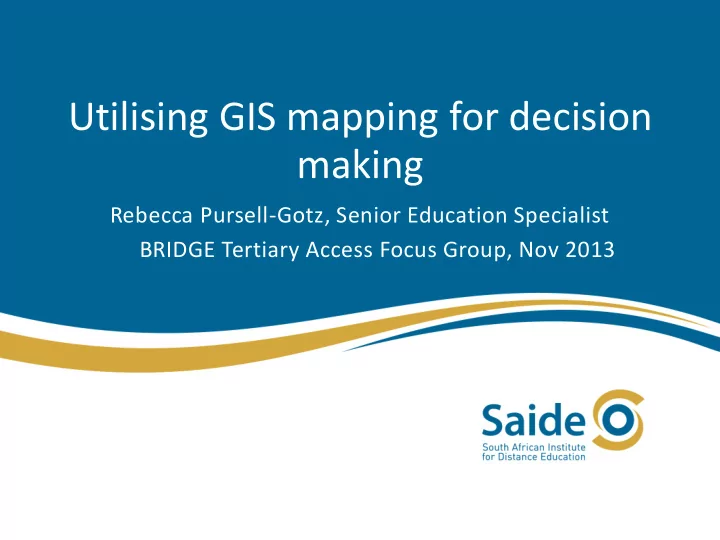

Utilising GIS mapping for decision making Rebecca Pursell-Gotz, Senior Education Specialist BRIDGE Tertiary Access Focus Group, Nov 2013
Purpose & Rationale • A large number of people in Gauteng who have not completed Grade 9 or 12 but very low enrolment at AET Centres • Centres across the province serving small numbers of learners despite location and population density – Need to identify areas where there are potential learner populations who are not being reached – Propose catchment areas per existing Centre to identify hard to reach populations (minimum distance catchments) – Centres that are poorly located/not offering what is required • GDE to use maps for decision-making
What we found • Programmes offered not aligned to target populations • Some Centres offering same programmes in very close proximity, but other key programmes not in place • Census data enabled us to make recommendations for the introduction/re- orientation of programmes
Methodology & Approach • Collect EMIS data and Census 2011 data – Look at age and highest level of education • Identify target groups for close consideration – Anyone with less than grade 9 – 18-24 years (NCS Candidates) with grade 11 as highest qualification – 25+ with grade 9 as highest qualification – Compare profile with enrolment • Create a GIS map using catchments and municipal data
Minimum distance catchments In Gauteng there are 47 AET (Adult Education and Training) Centres distributed across the province. Each of these will service sets of potential learners residing in a catchment where the centre is conveniently situated for their attendance of classes. – Where a set of target centres exist and each point represents a position of one of the members i.e. one of the 47 AET centres, a common requirement is to find out; – Those (places in) parts of the whole region (the province) which are closest to each individual (AET) centre?
Principles for construction of Minimum Distance Catchments In the diagram below there are seven points, each labelled and representing an individual centre. 1. We use a process called Thiessen Polygon construction (also known as Voronoi Polygons) to generate an answer to the above question. This is a mathematical process and the simplest means of explanation is to superimpose a regular grid (equidistant series of tick marks) on the region and determine for each grid tick which point (AET centre) of the target set is closest. This is calculated via a simple distance formula.
Principles for construction of Minimum Distance Catchments In the diagram below there are seven points, each labelled and representing an individual centre. 2. This is a mathematical process and the simplest means of explanation is to superimpose a regular grid (equidistant series of tick marks) on the region and determine for each grid tick which point (AET centre) of the target set is closest. This is calculated via a simple distance formula.
Principles for construction of Minimum Distance Catchments In the diagram below there are seven points, each labelled and representing an individual centre. 3. The result of this process shows the ticks coloured according to proximity to each of the points (AET centres) in the focus set. The average distance within a catchment is determined from the distance of each of the ticks, within that catchment, to the location of the AET centre.
Principles for construction of Minimum Distance Catchments In the diagram below there are seven points, each labelled and representing an individual centre. 4. A boundary is then drawn around all those ticks proximate to each target (seven in the diagram above) location. This completes the Thiessen (Voronoi) allocation based upon closest distances.
Possibilities • Can create a map where if you scroll over key areas, key data will pop up • At a strategic level, which areas are not sufficiently addressed, and who is working on those issues? • Where are the best intervention points?
Options? – Mapping learner data against current uptake vs. available services per catchment – Coverage of programmes at each level of the chain? – Creating a profile of learners from experience of participating organisations – What are the high risk locations for red links in the chain? • Map existing service providers against need (province?) • Map matric results
Other options to consider • Analyse census data of those above 20 years with a tertiary qualification, highest qualification and field of enrolment. This can be broken down into Small Area Layers (statistical geography) – not aligned with districts or municipalities • Quality of Life data generated by Gauteng City Region Observatory (GCRO) which has gathered information about time taken to travel and place travelling to.
Recommend
More recommend